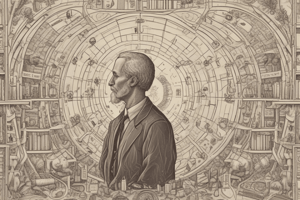Podcast
Questions and Answers
What is the primary objective of a formal organizational structure?
What is the primary objective of a formal organizational structure?
- To facilitate informal communication
- To promote employee autonomy
- To create a relaxed work environment
- To increase efficiency in production (correct)
According to Classical Theory, what maximizes production?
According to Classical Theory, what maximizes production?
- Informal teamwork
- Increased job satisfaction
- Specialization and division of labor (correct)
- Flexible job roles
Which of the following best describes a 'tall' organizational structure?
Which of the following best describes a 'tall' organizational structure?
- An equal distribution of authority amongst employees
- A flat structure with minimal hierarchy
- Few managers with many responsibilities
- Many subordinates reporting to few managers (correct)
What distinction does Bureaucracy (Max Weber) emphasize in organizations?
What distinction does Bureaucracy (Max Weber) emphasize in organizations?
What is the main focus of Scientific Management as proposed by Frederick Taylor?
What is the main focus of Scientific Management as proposed by Frederick Taylor?
Which training method involves the instructor physically standing in front of the students?
Which training method involves the instructor physically standing in front of the students?
What best describes 'In-basket training'?
What best describes 'In-basket training'?
Which of the following best defines the term 'Task Group'?
Which of the following best defines the term 'Task Group'?
What characterizes 'On-the-Job Training'?
What characterizes 'On-the-Job Training'?
What is a significant feature of an 'Interest Group'?
What is a significant feature of an 'Interest Group'?
What is essential for an organization to achieve its overall goals?
What is essential for an organization to achieve its overall goals?
Which role is responsible for processing salaries in an organization?
Which role is responsible for processing salaries in an organization?
In an organization that adopts Classical Theory, what is the significance of having a hierarchy?
In an organization that adopts Classical Theory, what is the significance of having a hierarchy?
What component is fundamental to the sustainability and success of an organization?
What component is fundamental to the sustainability and success of an organization?
Which of the following represents a basic component of organizations as per Classical Theory?
Which of the following represents a basic component of organizations as per Classical Theory?
What happens in a group when the free rider effect is present?
What happens in a group when the free rider effect is present?
What is a potential danger of high team cohesion?
What is a potential danger of high team cohesion?
Which conflict style involves avoiding the issue and hoping it resolves itself?
Which conflict style involves avoiding the issue and hoping it resolves itself?
In what situation is dictation most appropriately used as a conflict resolution method?
In what situation is dictation most appropriately used as a conflict resolution method?
What characterization of a team is most likely to enhance cohesion?
What characterization of a team is most likely to enhance cohesion?
Which style is characterized by a member giving in to the desires of others?
Which style is characterized by a member giving in to the desires of others?
What role does a mindguard play in a cohesive group?
What role does a mindguard play in a cohesive group?
What is an effective negotiation outcome when both parties work together?
What is an effective negotiation outcome when both parties work together?
What is the primary focus of Equity Theory as proposed by John Stacy Adams?
What is the primary focus of Equity Theory as proposed by John Stacy Adams?
Which of the following best describes inputs in the context of Equity Theory?
Which of the following best describes inputs in the context of Equity Theory?
What does the term 'Delayering' refer to in organizational structure?
What does the term 'Delayering' refer to in organizational structure?
How does disequity affect an employee's motivation according to Equity Theory?
How does disequity affect an employee's motivation according to Equity Theory?
In the context of organizational structure, what does centralization refer to?
In the context of organizational structure, what does centralization refer to?
What is the primary focus for making employees satisfied with their jobs, according to Hackman and Oldham?
What is the primary focus for making employees satisfied with their jobs, according to Hackman and Oldham?
Which of the following is NOT one of the five key elements identified for making tasks enjoyable?
Which of the following is NOT one of the five key elements identified for making tasks enjoyable?
How does skill variety contribute to job satisfaction?
How does skill variety contribute to job satisfaction?
What does autonomy in a job allow employees to do?
What does autonomy in a job allow employees to do?
What role does feedback play in an employee’s work environment?
What role does feedback play in an employee’s work environment?
According to Goal-Setting Theory, which characteristic is essential for effective goals?
According to Goal-Setting Theory, which characteristic is essential for effective goals?
What effect can repetitive tasks have on employees, according to the content?
What effect can repetitive tasks have on employees, according to the content?
Which of the following statements best describes the relationship between task enjoyment and organizational success?
Which of the following statements best describes the relationship between task enjoyment and organizational success?
Flashcards
Span of Control
Span of Control
The number of subordinates a supervisor can effectively manage.
Tall Organization Structure
Tall Organization Structure
An organizational structure with fewer subordinates per supervisor.
Flat Organization Structure
Flat Organization Structure
An organizational structure with more subordinates per supervisor.
Scientific Management
Scientific Management
Signup and view all the flashcards
Bureaucracy
Bureaucracy
Signup and view all the flashcards
Training Program Design
Training Program Design
Signup and view all the flashcards
Classroom Training
Classroom Training
Signup and view all the flashcards
On-the-Job Training
On-the-Job Training
Signup and view all the flashcards
Training Program Implementation
Training Program Implementation
Signup and view all the flashcards
Training Program Evaluation
Training Program Evaluation
Signup and view all the flashcards
Organizational Goals
Organizational Goals
Signup and view all the flashcards
Division of Labor
Division of Labor
Signup and view all the flashcards
Hierarchy
Hierarchy
Signup and view all the flashcards
Authority
Authority
Signup and view all the flashcards
Classical Theory
Classical Theory
Signup and view all the flashcards
Equity Theory
Equity Theory
Signup and view all the flashcards
Input (Equity Theory)
Input (Equity Theory)
Signup and view all the flashcards
Output (Equity Theory)
Output (Equity Theory)
Signup and view all the flashcards
Delayering
Delayering
Signup and view all the flashcards
Centralization
Centralization
Signup and view all the flashcards
Free Rider Effect
Free Rider Effect
Signup and view all the flashcards
Sucker Effect
Sucker Effect
Signup and view all the flashcards
Social Compensation
Social Compensation
Signup and view all the flashcards
Team Cohesion
Team Cohesion
Signup and view all the flashcards
Factors that Increase Cohesion
Factors that Increase Cohesion
Signup and view all the flashcards
Groupthink
Groupthink
Signup and view all the flashcards
Mindguard
Mindguard
Signup and view all the flashcards
Dictation
Dictation
Signup and view all the flashcards
What makes work enjoyable?
What makes work enjoyable?
Signup and view all the flashcards
Skill Variety
Skill Variety
Signup and view all the flashcards
Task Identity
Task Identity
Signup and view all the flashcards
Task Significance
Task Significance
Signup and view all the flashcards
Autonomy
Autonomy
Signup and view all the flashcards
Feedback
Feedback
Signup and view all the flashcards
Study Notes
Organizational Structure
- Organizational theory studies social organizations, including companies and bureaucracies, to understand and predict their behavior based on their structure.
- Organizations are collectives of parts that need to work together to achieve a shared goal.
- Key elements of a business include products, markets, money, and people.
Classical Theory
- Focuses on work, hierarchy, and formal organization structure.
- Believes in a structured approach to achieving organizational goals most effectively.
- Emphasizes efficiency in production.
- Key tenets include organization for economic reasons, finding the best way to organize, and maximizing productivity through specialization.
- Four major structural principles include functional, scalar, horizontal growth, and vertical growth.
Modern Organizational Theories
- Scientific Management (Taylorism). The focus is on workers' efficiency, breaking down tasks, and maximizing output.
- Administrative Management (Fayol). Focuses on managerial efficiency, methods to improve productivity by synchronizing internal processes, with the managerial performance being the most important.
Bureaucracy (Max Weber)
- Formal hierarchy, division of labor, and clear operating procedures are essential characteristics.
- Formal, orderly, and efficient functioning is the main goal.
- Important for organizations operating under consistently growing and stable environments.
Neoclassical (Human Relations) Theory
- Emphasizes employee needs and job satisfaction.
- More flexible than classical theory, accommodating employee needs alongside organizational goals.
Systems Theory
- Focuses on interrelationships and integrations within the organization, including individuals, formal organizations, groups, status, and roles.
- Interdependence and communication are crucial.
- Organization as an open system, interacting with its environment (inputs, processes, and outputs).
- Systems interact and support each other and are all interdependent.
Contingency Theory
- Emphasizes the best way to structure an organization is based on situational factors.
Motivation and Theories
- Motivation is the internal force that drives a worker's action.
- Intrinsic motivation comes from the enjoyment of the task, while extrinsic motivation comes from external rewards or avoidance of consequences.
- Self-esteem plays a role in performance, with higher self-esteem often correlating with better performance.
- Other motivation theories include Maslow's Hierarchy of Needs, Alderfer's ERG Theory, McClelland's Acquired Needs Theory, Herzberg's Two-Factor Theory, and Goal-Setting Theory.
Organizational Change
- Change agent, receptive changer, change analyst, and reluctant changer are different types of people during organizational change.
- Common resistance to change can occur on an individual or group/team level.
- Methods and processes like Lewin's Change Model support change management.
- Action research and appreciative inquiry are approaches to organizational change.
Organizational Structure & Design
- Various types of organizational structure (e.g., flat, tall, matrix, divisional, network) and departmentalization (geographic, functional, product-based, customer-based) are described to help organizations function most effectively under their certain circumstances.
- Elements such as span of control, centralization, and formalization affect organizational structure and function.
- Understanding the organization as a system is important to see how individual parts work together.
Group Dynamics
- Groups, and their characteristics including cohesion, and task interdependence, affect organizational performance and processes.
- Group roles (e.g., task-oriented, social-oriented) influence how a team functions.
- Social loafing is a phenomenon where people exert less effort in groups compared to working alone.
Human Resource Management
- HRM is the management of employees.
- HR managers have a responsibilities of manpower planning, staffing, maintaining the right relation and culture of employees, and evaluating employees.
- Employee motivation drives performance. The relationship between employer and employees must be well-established so that everyone is motivated and knows how to contribute towards a common goal.
- HRD (Human Resource Development) is focused on developing the future workforce, often using training programs.
Studying That Suits You
Use AI to generate personalized quizzes and flashcards to suit your learning preferences.




